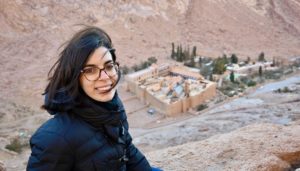
It was the beginning of a discovery Giulia Rossetto would only have imagined in her dreams when she realized that what she was looking at were faint Greek letters long hidden from view on a centuries-old parchment manuscript. Viewing the document on her laptop computer while traveling on a train from Vienna, Austria, to her home in Italy, she was examining faint images of Greek script long erased in antiquity and over-written by a later Arabic text on the leaves of a parchment book. She could only see them because the magic of state-of-the-art multi-spectral imaging made it possible for her to see what was otherwise invisible. Based on her studies and research, she knew that the script style suggested it was likely classical Greek written in Egypt in the 5th or 6th century A.D. She could decipher names of well-known mythological figures — Zeus, Persephone, Dionysus. Elated, she transcribed the text of what she saw.
Later, Giulia compared her transcriptions to other known ancient classical texts. In the initial stages of her research, nothing matched. But she eventually came to realize that what she was looking at was actually a literary fragment of a great ancient Greek epic poem, thought long lost and about which little is known to current scholarship. Popular Archaeology interviewed Giulia. This is what she had to say:
_________________________________
Q: What is the substance of your discovery?
GR (Giulia Rossetto): What survives are fragments from a longer poem written in hexameters, which is the most common verse used in epic poetry (Homer’s Iliad and Odyssey are written in hexameters). The two surviving folia preserve episodes dealing with the childhood of the god Dionysus. One folio refers to a dialogue between the goddesses Persephone and Aphrodite about the child, while the second folio describes how the Giants and other characters attempt to attract the child Dionysus away from the father’s throne in order to kill him. This text was copied in majuscule letters, probably in Egypt (Alexandria?), between the 5th and 6th c. after Christ. It was written in a luxurious large book and annotated and corrected over the centuries, at a certain point erased and in the early 10th c. replaced with an Arabic text at the Monastery of Mar Saba near Jerusalem.
_________________________________
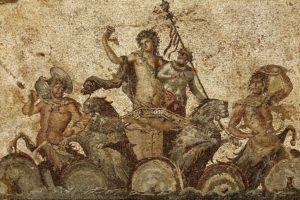
Epiphany of Dionysus mosaic, from the Villa of Dionysus (2nd century AD) in Dion, Greece. Now in the Archeological Museum of Dion. Public Domain, Wikimedia Commons
_________________________________
5th-6th c. after Christ is the date of the writing style of this text in this specific manuscript: however, the specific moment a text was copied rarely corresponds to the date of its composition. It is therefore probable that the poem is older, but it is difficult to say exactly when it was composed. And what could it be? One important hint can be found in the upper margin of one of the two folia: this is the number 23 and it could indicate the beginning of a book. This is written in the same fashion of the Homeric poems, which are arranged following the letters of the alphabet. In fact, this “23” is indicated by the Greek letter psi (ψ)and not by κγ΄, which would be the most common way to indicate this number. What do we know of lost epic poems with at least 23 books? My research led me to isolate one possible poem, which as far as we can read in the ancient sources had an editorial history similar to those of the Homeric poems: this is the so-called “Hieroi Logoi in 24 Rhapsodies”, i.e. the longest lost epic poem of which scholars are currently aware. So far, we only knew fragments of this poem by indirect tradition, i.e. through the quotations of ancient authors, in particular Neoplatonists like Porphyry or Proclus. The scholarly community has not yet agreed on the date of composition of the Hieroi Logoi: it seems that the material they are made of is quite ancient, but then were re-elaborated in the Hellenistic and in the Imperial time. The Hieroi Logoi were read and studied in Alexandria by the Neoplatonists in the 5th-6th c. and this would agree with the origin and date of the Sinai fragments.
________________________________
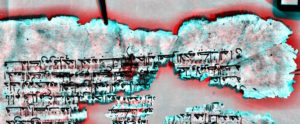
A multispectral processed image of the manuscript Sinai Arabic NF 66. © St. Catherine’s Monastery, Sinai, Egypt
________________________________
Q: What is your background education and experience as it relates to your work that led to this discovery?

Dr. Giulia Rossetto, Post-Doc researcher at the Austrian Academy of Sciences. Damianos Kasotakis
GR: I studied Classics in Italy, at the University of Padua and the Galilean School of Higher Education (http://www.unipd-scuolagalileiana.it/en/), and I was immediately fascinated by the study of Greek papyri: fragmentary documents written in a way that is at first sight incomprehensible. I encountered them for the first time through courses of Greek philology and Greek palaeography. In order to better understand how to work on such texts, I attended extra training courses of papyrology in Florence, Lecce, Bologna and Würzburg. Then, towards the end of my Master degree studies I moved to Vienna for an Erasmus stay. During that stay, I learned about a project in cooperation with the Department of Byzantine Studies of the University of Vienna: the Sinai Palimpsests Project (http://sinaipalimpsests.org/) of St. Catherine’s Monastery, the Early Manuscripts Electronic Library (EMEL) and the University of California Los Angeles (UCLA). The project was devoted to the recovery – by means of the most advanced technologies (multi spectral imaging and batch or supervised image processing) – of erased texts from a number of palimpsest manuscripts preserved in the middle of the desert: in the 6th century Monastery of St. Catherine (Sinai). Palimpsests are medieval books whose parchment leaves come from older parchment books, the text of which had been thoroughly erased. I soon realized that it was not only papyri that were fragmentary. Captivated by this project (which I had the delightful opportunity to join), I decided to remain in Vienna for my PhD. I am still in Vienna, currently as post-doc researcher at the Austrian Academy of Sciences, leading my own project.
_________________________________
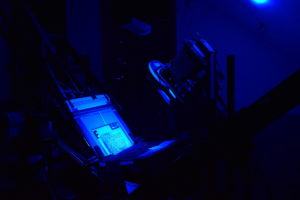
The camera system of the Sinai Palimpsests Project at St. Catherine’s Monastery: the palimpsest Sinai Syriac 30 on the Stokes Imaging Cradle, captured by Megavision camera with Equipoise light sources. © Damianos Kasotakis
_________________________________
Q: How did you get involved in researching/investigating this particular document?
GR: I began working with the Sinai Palimpsests Project as an assistant to Prof. Claudia Rapp, the project’s scholarly director. My role was to describe the Sinai palimpsests from a codicological point of view. This means understanding their structure and how they were assembled. We described the manuscripts onsite, at the Monastery of St. Catherine’s (an Eastern Orthodox monastery located on the Sinai Peninsula, at the foothills of Mount Sinai and the town of Saint Catherine, Egypt). During this period, I had the opportunity to work on several different palimpsests, written in a variety of languages, which greatly expanded my knowledge. Concurrent with this I was also one of about 30 scholars in charge of studying the erased texts: I was responsible for the Greek texts along with other scholars such as Pasquale Orsini, Agamemnon Tselikas and Nigel Wilson. Each scholar was assigned a number of manuscripts, with the task of deciphering, transcribing and identifying the texts in question. No one knew the contents at the beginning of our work. The subject manuscript discussed here, designated as Sinai Arabic NF 66, was entrusted to me in this way, towards the end of the project. It was a short text, only a couple of sheets, but surprisingly it turned out to be the one with the most surprises: fragments of a hitherto unknown text from classical antiquity.
Q: What was it like to do field research at the monastery: the physical environment, and the people with whom you interacted to do the work?
GR: Working at the monastery has been and continues to be a special experience and a wonderful privilege. I have learned a great deal from working side by side with manuscript experts, photographers, imaging scientists, data managers, just to mention some. At the monastery, I have always been well received by the Greek Orthodox monks, and especially by the librarian, Father Justin Sinaites. It was he who invited me to write my doctoral thesis – which will be published this coming summer in the form of a monograph – on some of the Sinaitic palimpsests, and this was one of the most exciting moments for me. During the stays, which usually last about ten days (although the director of photography and the camera operators stay much longer), we follow the rhythm of the monastic life: waking up at dawn, liturgy, study, lunch, study, vespers, and more study of the manuscripts.
_____________________________
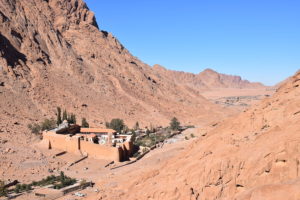
The Monastery of St. Catherine in southern Sinai (Egypt) houses one of the largest collections of medieval manuscripts, including palimpsests. © Damianos Kasotakis
_____________________________
Q: In your words, what is the biggest takeaway from your work on the palimpsest and the implications of your work?
GR: The study of palimpsests has taught me that books and the writing support from which they are made (parchment) have actually traveled much further than most people think. The manuscripts now in Sinai come from many places: Crete, Cyprus, Jerusalem, southern Italy, to name but a few. Often scribes worked in multilingual contexts, as some Sinai palimpsests copied on top of erased parchment sheets originating from several different books written in Greek, Arabic, Georgian, and Syriac attest. Working on palimpsests has also taught me – as a trained classical philologist – that all texts are interesting and worthy of study, not just classical texts. (Less than 4% of the texts preserved at St Catherine’s contain a known or unknown work of classical antiquity). There is a reason why they were no longer used and this is worth investigating in order to understand more of the textual preferences of the time: why people discarded them, their reasons, and the milieu in which they lived. This made me look at my discipline and my work with new eyes.
Q: Why do you think it is important to discover/reveal the content of these ‘hidden’ writings?
GR: It is important because they give us an insight into texts, languages and scripts that we did not know before or about which we did not know much. I can explain this the following way:
Texts: During the project work, completely unknown texts came to light. One example: the fragments from the Orphic Rhapsodies which I discovered in manuscript Sinai Arabic NF 66. But there are also previously unknown texts of a biblical or liturgical nature.
Languages: Some languages are known to us only or largely from the Sinai palimpsests, such as Caucasian Albanian or Christian Palestinian Aramaic.
Scripts: Palimpsests are a very important source of information for reconstructing the history of the early stages of Greek writing on parchment rolls or codices. This is because between the eighth and ninth centuries, when minuscule writing began to prevail over majuscule writing in books, many texts written in capital letters were destroyed, erased, and used as recycling material. Now they can be brought back to light thanks to multispectral imaging.
I also think it is very important that this precious material (images, metadata, and description) be made available open-access online.
Q: What discoveries or findings have been made since your last published discovery by the media?
GR: Scholars affiliated with the project constantly publish their findings in scientific journals. During the Sinai Palimpsests Project, 74 palimpsests were multispectral imaged and underneath these 74 manuscripts 307 erased texts were recovered. They were all preliminarily identified, but the material still requires further investigated in depth. For example, I recently recovered the text of a previously unknown Typikon (the “rule” of a monastery) that was written for a community in southern Italy (Salento, Apulia) and thereafter erased, rewritten in Greek with a Byzantine prayer book and brought to St. Catherine’s Monastery, on the other side of the Mediterranean.
Other recent discoveries:
Alexander Treiger has identified a 10th or 11th century Arabic version of Genesis and Exodus. This was probably a translation from Hebrew into Arabic made for an Arab-speaking Jewish community in North Africa. This is a very rare presence of Old Testament text from the Jewish tradition that owes its survival to a Christian context.
Grigory Kessel has recovered 29 different texts within a single Sinai palimpsest: Sinai. Arabic 514. Among these there are works which were previously considered lost: Ephrem the Syrian, Against the Jews, as well as a very early herbal in Syriac.
These and other discoveries are featured in a volume that will see the light later this year: C. Rapp – G. Rossetto – J. Grusková – G. Kessel (ed.), New Light on Old Manuscripts: The Sinai Palimpsests and Other Advances in Palimpsest Studies [Forthcoming in: Veröffentlichungen zur Byzanzforschung, Vienna, Verlag der Österreichischen Akademie der Wissenschaften]
Q: What are your plans going forward related to the palimpsest and/or related documents?
GR: After the publication of the edition of the hexameters in the palimpsest Sinai Arabic NF 66 in the scientific journal Zeitschrift für Papyrologie und Epigraphik (ZPE), my fellow imaging scientists were able to make better and more readable images of the palimpsest sheets, thanks to which I was able to read many more words and better understand the narrative scenes. For this reason, I organized a small workshop in the autumn of 2021 in which classical philologists and experts of ancient religion from all over the world took part. One of the results I can anticipate is that the metrical analysis of the Sinai hexameters has shown that the material cannot be dated after the 4th c. BC (classical period), but the frequent repetitions make us think that this very old material was probably reworked in the following centuries.
The results of this workshop will be published in the form of a new edition of the text later this year, again in the journal ZPE.
Other than the specific investigation of this very palimpsest, the Monastery of St. Catherine preserves over 170 palimpsests. Less than half of them (74) were imaged during the first phase of the Sinai Palimpsests Project, which was funded by the Arcadia Fund of London. My dream would be to see the digitization of the palimpsests at the monastery continue. But for now, we can only anticipate the continuation of this great project, perhaps in the form of a second phase, and hope it will soon be possible.
During the summer my monograph will be published, which will offer an overview of the Greek palimpsests preserved in the monastery of St Catherine: Greek Palimpsests at Saint Catherine’s Monastery (Sinai): Three Euchologia as Case Studies [Forthcoming in: Veröffentlichungen zur Byzanzforschung, Vienna, Verlag der Österreichischen Akademie der Wissenschaften]
___________________________________
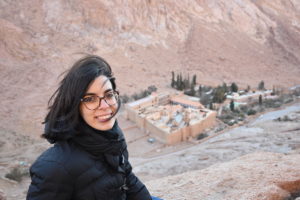
View of St. Catherine’s Monastery, Sinai, Egypt. In the foreground: researcher Giulia Rossetto from the Austrian Academy of Sciences. © Damianos Kasotakis
___________________________________
Advertisement





